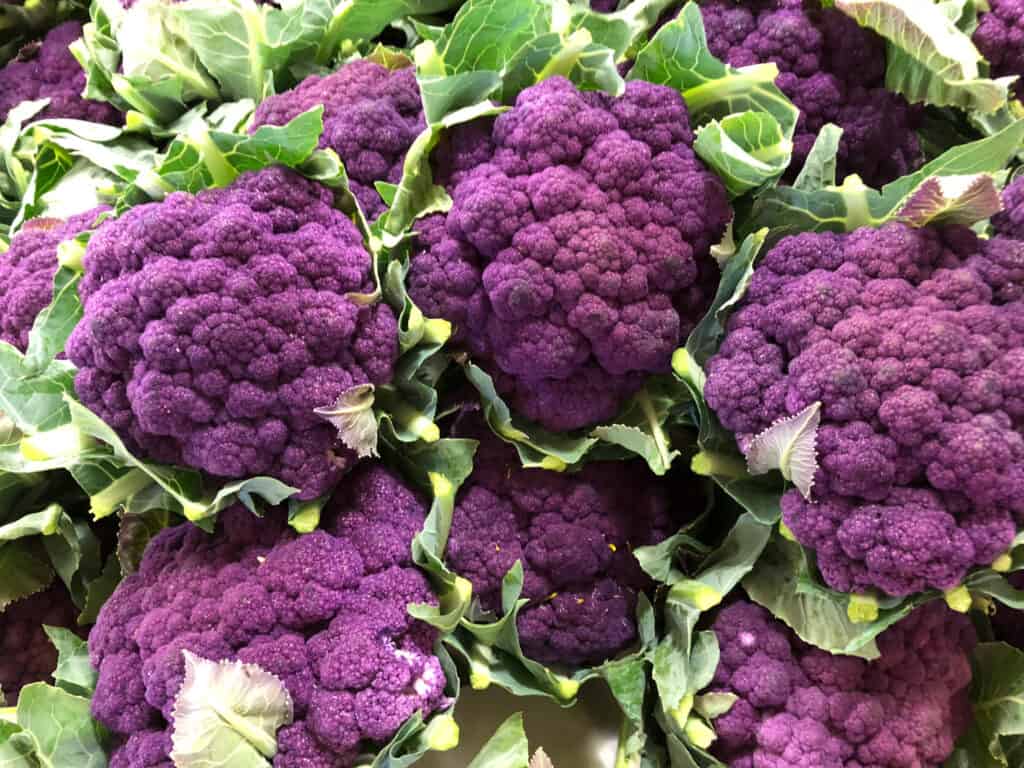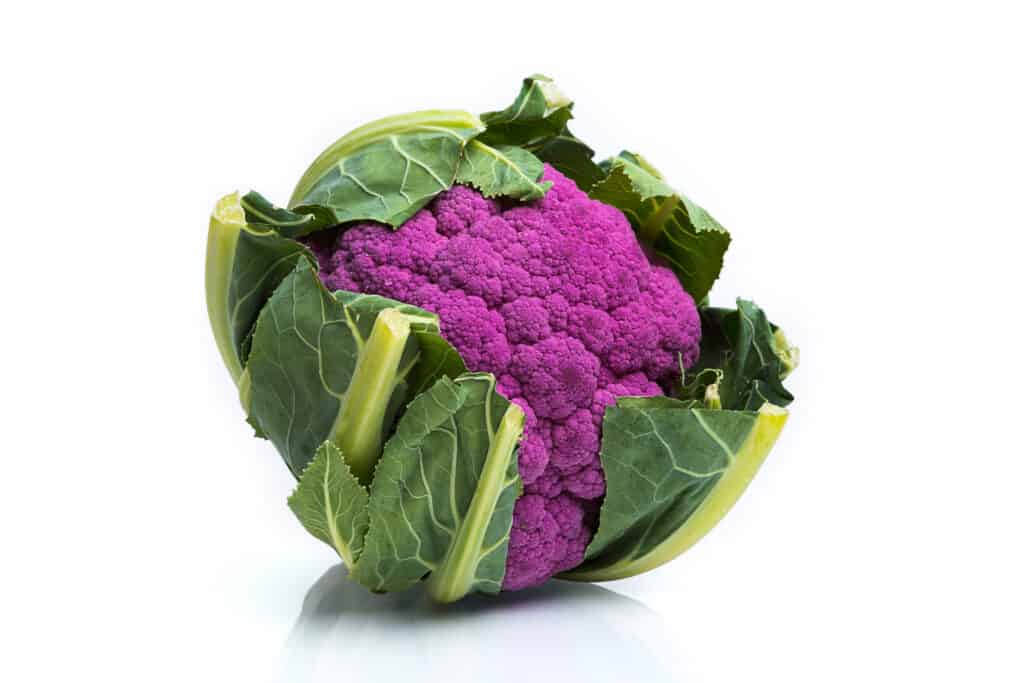Cauliflower has been around for a long time, as early as the 12th century. The word cauliflower is derived from the Italian word cavolfiore, which means cabbage flower. Early western Europeans traded cauliflower seeds to grow and described them as having the best taste of all cabbages. They still hold an honorable place in many home gardens because of their delicate flavor.
There are four colors of cauliflower commonly sold in supermarkets and seed catalogs; purple, green, orange, and white. The colorful varieties were bred through the slow process of selective breeding and are not genetically modified.
Here we will discuss the similarities and differences between white and purple cauliflower.
Comparing White Cauliflower vs Purple Cauliflower

An adequately grown white cauliflower can be as wide as 10 inches across.
©iStock.com/Tim UR
| Characteristic | Purple Cauliflower | White Cauliflower |
|---|---|---|
| Description | Purple head that is 6-7 inches, green leaves that are short | White head that is 8-10 inches, green leaves that are long enough to encase cauliflower head |
| Nutrients per 100 grams (1 cup) | 2 grams protein. 5 grams carbohydrate. 77% DV Vitamin C, 400 milligrams of anthocyanins. | 2 grams protein. 5 grams carbohydrate. 77% DV Vitamin C. |
| Taste | Nutty and sweet, zero bitterness | nutty and sweet, mildly bitter aftertaste |
| Family | Brassica Oleracea | Brassica Oleracea |
| Growing | Cool season annual. Takes 80-110 days to mature. Plant in July or August for a winter crop. | Cool season annual. Takes 80-110 days to mature. Plant in July or August for a winter crop. |
| Climate | 70-85 degrees Fahrenheit maximum. The prolonged summer sun will cause the plant to bolt. Plenty of moisture and organic hummus in the soil. | 70-85 degrees Fahrenheit maximum. The prolonged summer sun will cause the plant to bolt. Plenty of moisture and organic hummus in the soil. |
| Propagation | Reproduces by seed | Reproduces by seed |
| Cooking | Dry heating is best. Roast, grill, or air fry | Moist heat is best. Stir-fry, steam, or microwave. |
| Texture | Grainier and better for roasting, creating cauliflower pizza crusts, or other crispy recipes | Smoother and better for cauliflower mashed potato or other pureed recipes |
The Differences Between Purple Cauliflower vs White Cauliflower
The key differences between the purple cauliflower vs white cauliflower is color, taste, cooking, nutrients, and texture.
Purple Cauliflower vs White Cauliflower: Color and Size

The purple cauliflower rarely exceeds 6 inches.
©iStock.com/MartinPBGV
The most significant difference between the two cauliflowers is color, one is a very bright purple, and the other is a creamy white. They also grow to different sizes in the garden. An adequately grown white cauliflower can be as wide as 10 inches across. While the purple cauliflower rarely exceeds 6 inches.
The leaf length is also different. White cauliflower has adapted to protect itself from the hot sun by growing very long leaves that wrap around the head to keep the sun from burning them. Purple cauliflower is newer to the scene and has much shorter leaves that only barely reach the sides of the cauliflower head.
Purple Cauliflower vs White Cauliflower: Nutrients

White cauliflower has a moist and creamy texture when cooked. It is best for cauliflower mashed potatoes, smoothies, or moist baked goods.
©iStock.com/Tim UR
Purple and white cauliflower contain the same amount of protein, carbohydrates, and Vitamin C. However, purple cauliflower is purple thanks to an antioxidant called Anthocyanin. This powerful antioxidant has been shown in several recent studies to contain anti-cancer properties.
We can find the phytochemicals isothiocyanate and glucosinolate in both white and purple cauliflower. If you cook cauliflower by boiling it in water, you will throw most of the nutrients away with the water. But if you cook by steaming, microwaving, air frying, or stir-frying, there is only a slight decrease in nutrition. You can also choose to eat either color of cauliflower raw.
Purple Cauliflower vs White Cauliflower: Taste and Culinary Uses

Purple cauliflower is purple thanks to an antioxidant called Anthocyanin.
©iStock.com/bluebeat76
Another difference between these two cauliflowers is the final texture after cooking. Purple cauliflower has a drier texture and lends itself to recipes that need to be crispy, such as crunchy salad toppings, vegetable roasts, or pizza crusts. White cauliflower has a moist and creamy texture when cooked. It is best for cauliflower mashed potatoes, smoothies, or moist baked goods.
There is also a slight difference in taste to mention. Many people describe a slightly bitter aftertaste with white cauliflower, but this is not present in the purple variety.
Purple Cauliflower vs White Cauliflower: Growth and Climate

Cauliflowers prefer an absolute maximum temperature of 85 degrees Fahrenheit but between 60-70 degrees for ideal growth.
©iStock.com/Baloncici
Purple and White cauliflower have identical growing requirements. They love a cool climate and are best grown as a fall or winter crop. They prefer an absolute maximum temperature of 85 degrees Fahrenheit but between 60-70 degrees for ideal growth. If you live in an area with prolonged summer heat, you will want to plant your cauliflower seeds in mid-August for a lovely fall crop.
The seeds germinate in 7-10 days, and the plant is fully mature and ready to harvest in 80-110 days. Keep the soil moist and incorporate a large quantity of organic matter into the soil before planting. Cauliflower is a member of the cabbage family. It is a cool-season annual, and you need to replant it yearly. Try planting orange or green cauliflower next year!
NEXT UP:
- 19 Vegetables to Plant in September. Here is a great list of vegetables that do well as fall or winter crops.
- 7 Extinct Fruits Did you know that there are some fruits extinct from the earth? Here is a list of 7 extinct fruits.
- Grape Tomato vs Cherry Tomato: Is There a Difference? Have you ever wondered about all the variety of tiny tomatoes at the supermarket? Here is a comparison of two popular types of tomatoes.
The photo featured at the top of this post is ©
Thank you for reading! Have some feedback for us? Contact the AZ Animals editorial team.






